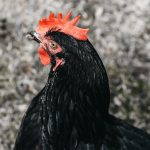Maintaining optimal temperature for meat chickens is critical for their health, welfare, and productivity. Exposure to high temperatures can cause heat stress, leading to various physiological and behavioral changes in chickens. These include excessive panting, reduced feed intake, dehydration, electrolyte imbalances, and compromised immune function.
Heat stress can significantly impair growth rates, feed conversion efficiency, and overall performance of meat chickens. Temperature management is also crucial for meat quality. Heat-stressed chickens are more likely to develop conditions such as “woody breast,” characterized by tough, fibrous muscle tissue.
This condition negatively affects meat texture, palatability, and market value. By implementing effective cooling strategies, poultry farmers can mitigate these risks and ensure the production of high-quality chicken meat. Proper temperature control in meat chicken production is essential for animal welfare, economic viability, and consumer satisfaction.
Poultry farmers must employ various cooling techniques, such as adequate ventilation, evaporative cooling systems, and appropriate stocking densities, to maintain optimal environmental conditions for their flocks. Regular monitoring of temperature and humidity levels, along with prompt intervention when necessary, is crucial for successful meat chicken production.
Table of Contents
- 1 Providing Adequate Ventilation in the Chicken Coop
- 2 Using Shade and Cooling Methods in the Chicken Run
- 3 Offering Chilled Water and Hydration Techniques
- 4 Monitoring and Managing Heat Stress in Meat Chickens
- 5 Adjusting Feeding and Activity Times to Avoid Heat
- 6 Implementing Emergency Cooling Measures for Extreme Heat Events
- 7 FAQs
- 7.1 What are some ways to keep meat chickens cool?
- 7.2 Why is it important to keep meat chickens cool?
- 7.3 How can I provide shade for meat chickens?
- 7.4 What are some signs of heat stress in meat chickens?
- 7.5 How can I improve ventilation for meat chickens?
- 7.6 How often should I check on my meat chickens during hot weather?
Key Takeaways
- Keeping meat chickens cool is important for their health and well-being, as they are susceptible to heat stress.
- Adequate ventilation in the chicken coop is crucial to allow for air circulation and prevent the buildup of heat.
- Using shade and cooling methods in the chicken run, such as misters or fans, can help lower the temperature and provide relief for the chickens.
- Offering chilled water and using hydration techniques, such as adding electrolytes to the water, can help prevent dehydration in meat chickens during hot weather.
- Monitoring and managing heat stress in meat chickens is essential, and implementing emergency cooling measures for extreme heat events is necessary to prevent heat-related illnesses or fatalities.
Providing Adequate Ventilation in the Chicken Coop
Why Ventilation Matters
Adequate ventilation in the chicken coop is crucial for maintaining a cool and comfortable environment for meat chickens. Proper ventilation helps to remove excess heat, moisture, and airborne contaminants from the coop, creating a healthier and more comfortable living space for the birds. Ventilation also plays a vital role in preventing the buildup of ammonia and other harmful gases that can result from chicken waste, which can negatively impact the respiratory health of the birds.
Providing Adequate Ventilation
To mitigate the risk of heat stress and respiratory issues in meat chickens, poultry farmers should ensure that their chicken coops are well-ventilated. There are several ways to provide adequate ventilation in the chicken coop, including installing windows, vents, and fans to promote air circulation. Natural ventilation can be achieved by strategically placing windows and vents to allow for cross-ventilation, while mechanical ventilation systems such as fans can be used to enhance airflow during hot weather.
Additional Considerations
Proper insulation and roofing materials can also help regulate the temperature inside the coop, preventing it from becoming too hot during the summer months. By prioritizing adequate ventilation in the chicken coop, poultry farmers can create a more comfortable and healthy environment for their meat chickens, reducing the risk of heat stress and respiratory problems.
Using Shade and Cooling Methods in the Chicken Run

In addition to providing a well-ventilated coop, it is important to implement shade and cooling methods in the chicken run to protect meat chickens from excessive heat. Direct exposure to sunlight can significantly increase the temperature in the chicken run, leading to heat stress and discomfort for the birds. Therefore, providing ample shade in the chicken run is essential for creating a cooler and more comfortable outdoor space for the chickens.
This can be achieved by planting trees or installing shade cloth to block out direct sunlight and reduce the ambient temperature in the chicken run. Furthermore, implementing cooling methods such as misting systems or evaporative coolers can help lower the temperature in the chicken run during hot weather. These systems work by releasing fine water droplets into the air, which evaporate and absorb heat, effectively cooling down the surrounding environment.
Additionally, placing shallow containers of water or providing access to a shallow wading pool can offer chickens the opportunity to cool off by standing or wading in the water. By utilizing shade and cooling methods in the chicken run, poultry farmers can create a more comfortable outdoor environment for their meat chickens, reducing the risk of heat stress and ensuring their well-being.
Offering Chilled Water and Hydration Techniques
Proper hydration is essential for meat chickens to regulate their body temperature and prevent heat stress during hot weather. Poultry farmers should ensure that chickens have access to an adequate supply of chilled water throughout the day to help them stay cool and hydrated. Offering chilled water can help lower the birds’ body temperature and encourage them to drink more frequently, reducing the risk of dehydration and heat stress.
Additionally, adding electrolytes or vitamin supplements to the water can help replenish essential nutrients lost through panting and sweating, supporting the overall health and well-being of meat chickens during periods of high heat. In addition to offering chilled water, poultry farmers can implement hydration techniques such as providing water-rich fruits and vegetables as treats for the chickens. Cucumbers, watermelon, and lettuce are examples of hydrating foods that can help supplement the chickens’ water intake while providing essential nutrients.
Furthermore, regularly cleaning and maintaining waterers to ensure they are free from algae, debris, and contaminants is crucial for promoting good hygiene and encouraging chickens to drink an adequate amount of water. By offering chilled water and implementing hydration techniques, poultry farmers can support the hydration needs of their meat chickens, helping them stay cool and healthy during hot weather.
Monitoring and Managing Heat Stress in Meat Chickens
Monitoring and managing heat stress in meat chickens is essential for preventing health issues and ensuring their well-being during periods of high temperatures. Poultry farmers should regularly observe their chickens for signs of heat stress, such as panting, wing spreading, reduced activity, or decreased feed intake. Monitoring the birds’ behavior and physical condition can help identify early signs of heat stress, allowing farmers to take prompt action to mitigate its effects.
Additionally, using tools such as thermometers or heat stress indicators in the coop and chicken run can help farmers track temperature levels and assess the risk of heat stress in their meat chickens. When signs of heat stress are observed, it is important to take immediate measures to manage the condition and prevent further complications. This may include providing additional shade, cooling methods, and chilled water to help lower the birds’ body temperature and alleviate heat stress symptoms.
Farmers should also consider adjusting feeding times to cooler parts of the day and reducing physical activity during peak temperatures to minimize heat exposure for the chickens. By monitoring and managing heat stress in meat chickens proactively, poultry farmers can safeguard their health and well-being, reducing the risk of heat-related illnesses and mortality.
Adjusting Feeding and Activity Times to Avoid Heat

Optimizing Feeding Times
During periods of extreme heat, poultry farmers should consider adjusting feeding times for meat chickens to minimize their exposure to high temperatures. Feeding chickens during cooler parts of the day, such as early morning or late evening, can help reduce metabolic heat production associated with digestion while ensuring that chickens have access to fresh feed when they are most active. By scheduling feedings during cooler times, farmers can help prevent excessive heat generation in meat chickens and promote better feed intake and digestion.
Adjusting Activity Times for Tasks and Natural Behaviors
Similarly, adjusting activity times for tasks such as cleaning, maintenance, or handling of chickens can help minimize heat exposure for both farmers and birds. Performing these activities during cooler periods of the day can reduce stress on both parties while ensuring that essential tasks are completed without compromising the well-being of meat chickens. Additionally, providing opportunities for chickens to engage in natural behaviors such as foraging or dust bathing during cooler times can help promote their physical and mental well-being while minimizing heat-related stress.
Creating a Comfortable Environment for Meat Chickens
By adjusting feeding and activity times to avoid heat, poultry farmers can create a more comfortable environment for their meat chickens while promoting their overall health and productivity. This approach can help reduce heat-related stress and improve the overall well-being of meat chickens, leading to better health and productivity outcomes.
Implementing Emergency Cooling Measures for Extreme Heat Events
In cases of extreme heat events, poultry farmers should be prepared to implement emergency cooling measures to protect their meat chickens from heat stress and related health issues. This may include using portable fans or misting systems in the chicken coop or run to lower the ambient temperature quickly. Farmers should also consider relocating chickens to a cooler area if possible or providing additional shade using temporary structures or tarps to shield them from direct sunlight.
Furthermore, offering frozen treats such as ice blocks or frozen fruits can provide temporary relief from heat stress for meat chickens while encouraging them to stay hydrated. Farmers should also closely monitor their birds during extreme heat events, paying attention to signs of distress or illness and taking immediate action to address any issues that arise. Additionally, having a contingency plan in place for extreme heat events, including access to emergency supplies such as ice packs or electrolyte solutions, can help poultry farmers respond effectively to unexpected challenges related to high temperatures.
In conclusion, implementing emergency cooling measures for extreme heat events is crucial for protecting the health and well-being of meat chickens while ensuring their resilience during adverse weather conditions. By being proactive and prepared to address extreme heat events, poultry farmers can minimize the impact of heat stress on their birds while promoting a safe and comfortable environment for meat chicken production.
If you’re looking for more information on how to keep your meat chickens cool, you might want to check out this article on the best kind of coop for chickens. It offers valuable insights into creating a comfortable and suitable environment for your chickens to thrive. Read more here.
FAQs
What are some ways to keep meat chickens cool?
Some ways to keep meat chickens cool include providing shade, proper ventilation, and access to cool water.
Why is it important to keep meat chickens cool?
Keeping meat chickens cool is important because they are susceptible to heat stress, which can lead to illness and even death.
How can I provide shade for meat chickens?
You can provide shade for meat chickens by using tarps, umbrellas, or natural shade from trees or buildings.
What are some signs of heat stress in meat chickens?
Signs of heat stress in meat chickens include panting, lethargy, decreased egg production, and loss of appetite.
How can I improve ventilation for meat chickens?
You can improve ventilation for meat chickens by using fans, opening windows or vents, and ensuring that the coop is not overcrowded.
How often should I check on my meat chickens during hot weather?
During hot weather, it is important to check on your meat chickens frequently, at least every few hours, to ensure they are not showing signs of heat stress.
Meet Walter, the feathered-friend fanatic of Florida! Nestled in the sunshine state, Walter struts through life with his feathered companions, clucking his way to happiness. With a coop that’s fancier than a five-star hotel, he’s the Don Juan of the chicken world. When he’s not teaching his hens to do the cha-cha, you’ll find him in a heated debate with his prized rooster, Sir Clucks-a-Lot. Walter’s poultry passion is no yolk; he’s the sunny-side-up guy you never knew you needed in your flock of friends!








